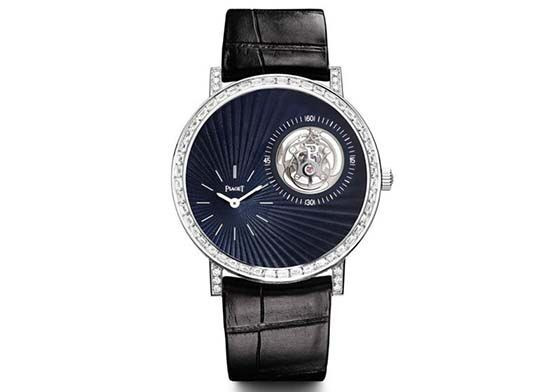Why The Mania For Tourbillons Never Dies
Sponsored content from Modern Luxury
After two decades of worldwide popularity, and the rise of other complications, one might have thought that the mania for tourbillons might have died down somewhat — but nothing could be further from the truth. Constructing a tourbillon remains a rite of passage for any watchmaking brand seeking to confirm or establish a reputation among the upper echelons of the industry and for any lover of ultra-refined timepieces. But in order to hold on to its exceptional status, this mechanism (created at the very beginning of the 19th century in order to cancel out the negative effects of gravity on the accuracy of pocket watches) has had to reinvent itself.
New technical approaches, more suited to wristwatches — double, triple, even quadruple tourbillons, multi-axis tourbillons, etc. — are cropping up everywhere. Watchmakers are also reinterpreting the fascinating spectacle of these small rotating carriages, transforming them into spaceships that seem to float through nothingness, or animated sculptures that incorporate several different rotational speeds.

Breguet invented the tourbillon to compensate for fluctuations in a pocket watch's functioning due to gravity. Pocket watches were usually carried in a special pouch or fob on a trouser belt, waistcoat or jacket: hence the name. Thus maintained in a vertical position for many hours, the mechanism — starting with the balance and the balance-spring, two necessary components for accuracy and precision — underwent the detrimental effects of gravity. To avoid such irregularities, the famous watchmaker Abraham-Louis Breguet (1747-1823), one of the greatest horological geniuses of all time, had the idea of enclosing the heart of the watch (balance, balance-spring and escapement) within a small mobile carriage spinning on its axis within a predetermined time (generally one, four or six minutes). It was for this rotation that he chose to name his invention tourbillon — a term from astronomy synonymous with "planetary system" among 18th-century scientists. Breguet submitted the patent for his watch, compensating for all the inequalities that occur in the balance and balance-spring, on the 7th of Messidor in the 9th year of the Republican calendar — otherwise known as June 6, 1801. According to the house's archives, 35 tourbillon watches were sold between 1805 and 1823, and throughout the 19th century the tourbillon remained an extremely rare complication, reserved for a few exceptional timepieces.

The 20th-century triumph of the wristwatch could have brought about the disappearance of the tourbillon, as the complication loses much of its significance when the watch moves in all directions with the movement of the wearer's wrist. However, the revival of mechanical horology in the 1980s propelled this mechanism into the firmament of horological complications by positing it as the nec plus ultra of Swiss savoir-faire, conferring upon any watchmaker entry into the ranks of the great. Since the turn of the millennium, the tourbillon has become wildly popular. Whereas only 670 tourbillons were produced between 1801 and 1986, today the global production stands at well over 1,000 per year. Over 50 Swiss brands offer them among their collections, which is surprising when one considers that only a small handful of artisans are really capable of making this small magic carriage. Faced with this (relative) banalization, the major watch firms are determined to offer in-house tourbillons featuring new technical and aesthetic developments.

HOW DOES IT WORK?
Placed horizontally, a watch's regulating organ (balance, balance-spring and escapement) is uniformly affected by the Earth's gravitational pull. However, when it is placed vertically (and to a lesser extent, in any position besides the horizontal), gravitational force causes certain fluctuations in its functioning and oscillations. These small accelerations and decelerations cause irregularities in the watch's functioning. The idea behind the tourbillon is to place the regulating organ in a small mobile carriage that completes one rotation in a given time, usually one minute. By successively adopting all possible positions, the carriage allows the small irregularities to cancel each other out. The tourbillon carriage is a tiny construction that may contain 70 components with a weight of less than 1g. This is why the production, assembly and setting of a tourbillon watch require exceptional expertise, reserved for the most elite watchmakers and incompatible with mass production.

TOURBILLONS AND PRECISION
The tourbillon was created for the pocket watch, which spends most of its time in a vertical position. It is less necessary on a wristwatch, when the daily movements of the wearer's wrist play the same role as the tourbillon in putting the regulating organ in a variety of positions. Some people go so far as to say that the tourbillon is completely useless in its classic form. To solve this problem, a new generation of tourbillons has arrived — with diverse variations on the manners, axes and speeds of rotation — that supposedly offers enhanced performances for wristwatches. Nonetheless, even though the tourbillon is not in itself synonymous with increased accuracy, the expertise necessary to create such a watch, and the extreme care involved in its production, are both guarantees of a watch that offers superior performance.

FLYING TOURBILLON
Normal tourbillons are supported by two bridges, one above the mechanism and the other below. Flying tourbillons are supported by only one, below the mechanism, which allows the watchmaker to give the construction a more ethereal and resolutely virtuoso appearance.

TOURBILLON AND KARUSSEL
Patented by the Danish Bonniksen in 1892, the karussel has the same ultimate goal as the tourbillon. However, it is distinguished (or could be distinguished — the experts do not all agree) by the double wheel train that links it to the barrel: the first provides the necessary energy for the functioning of the escapement, and the second controls the speed of the carriage's rotation.





















